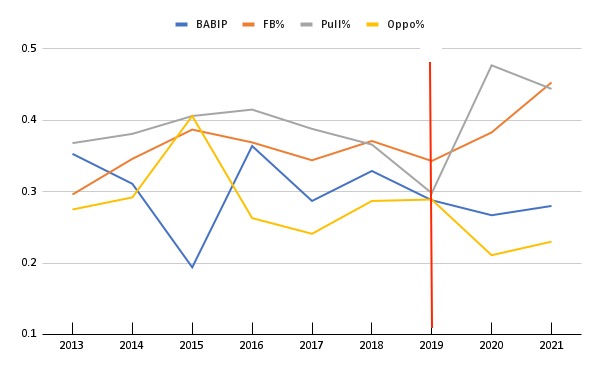In what has been a banner year for Robbies, Robbie Grossman has put up career highs in homers, runs, RBI, stolen bases, and WAR, in his age-31 season. All that in just over 120 games played and across 521 plate appearances. He’s done so for a Tigers team that fleeced the free-agent market with a January signing that netted Grossman $10 million for a two-year deal.
After languishing as an average-ish hitter across seven seasons with Houston, Minnesota, and Oakland, in mostly part-time seasons, Grossman broke out in a big way with A’s in 2020, albeit in a shortened season. That the Tigers were the best option for Grossman perhaps is telling in what teams thought of a short career year for a 30-yea- old that had never eclipsed 11 home runs in a season.
To be fair, there aren’t many 30-year-olds that demonstrate a drastic change in skills almost overnight so some scepticism was warranted; however, the more interesting breakouts in baseball come not from skill development, which happens all the time. Rather, Grossman’s breakout was a change in approach.
Grossman has always shown an advanced approach at the plate, never walking less than 12% of the time in seasons he had above 300 plate appearances while running a 21% strikeout rate for his career. In 2020 though, Grossman completely revamped his approach. He still walked a lot and struck out at a decent enough rate, but changed what he did with the ball when he did swing:

The red line demarcates the change in his approach after 2019. Grossman stopped running high BABIPs while he was pulling the ball more than ever and at the expense of going to the opposite field. Meanwhile, he hit the ball in the air more than ever.
Essentially, Grossman was giving up batting average for pulled fly balls and it worked to his advantage, hitting the second-most home runs and highest WAR in a season of his career, despite that season being all of 192 plate appearances.
Grossman has largely continued that trend in 2021, increasing his flyballs still, now placing him in the 87th percentile among all qualified hitters this season. It’s worked to tremendous effect, with 19 home runs to pair with an excellent .358 on-base percentage through Tuesday’s games.
It’s a bit of an old-new approach of the much-talked-about flyball revolution of the past several years. While the narrative focus of hitter development has largely shifted onto changes in the ball and pitching this year, there are still hitters that are deciding to “hit the ball in the air hard” and seeing the results follow.
Looking at the hitters that have most improved their flyball and pull rates may offer clues to the others that have optimized for approach development in the past year. The pandemic-shortened 2020 season provides both a smaller sample size and one that is more likely to fluctuate, but there are some hitters who have followed Grossman’s “elevate and celebrate” 2021.
Below are the top three batters who have most increased their flyball and pull rates combined (the full leaderboard among hitters with 300 or more PA this season can be found here).
Chris Taylor, LAD, +15% pull rate, +12% flyball rate
Taylor has changed his approach in these metrics more than anyone in baseball, and it’s not particularly close. His flyball rate increase is nearly 30% higher than the next highest in 2021 (José Altuve), and his pull rate is the second-highest increase this year.
If there’s a poster child for the pull-flyball revolution’s success, it’s Chris Taylor’s 2021.
Unlike Grossman, though, Taylor has paired his newfound approach with more advanced plate discipline, walking more in the past two seasons in which he ever had previously in his career. Taylor is on pace for his highest career WAR and wRC+ seasons.
Jorge Polanco, MIN, +16% pull rate, +5% flyball rate
Unlike Taylor, Jorge Polanco isn’t hitting the ball in the air at such an extreme rate, but is instead realizing most of his approach gains through pulling the ball at an increase higher than anyone from 2020-2021.
It’s been somewhat of a lost season for the Twins, and so Polanco perhaps hasn’t been given the due credit he deserves from his outstanding season, which, like the other players on the list, is adding up to a higher WAR and wRC+ pace of his career, even as his BABIP continues to decline, as was the case with Taylor and Grossman.
José Altuve, HOU, +12% pull rate, +9% flyball rate
Altuve has hit the ball in the air and pulled it more this season than in any previous year in his career. He’s going the opposite way with the ball nearly a third less than his career average. After Altuve’s career-worst season last year, managing just a 77 wRC+, Altuve’s new approach has paid off dividends thus far with a 133 wRC+ and 4 fWAR.
Still, it’s a bit surprising to see Altuve on this leaderboard, as he’s had such success with his all-fields approach throughout his career. Last season he posted the highest “speed” score of his career (89), though this year it is down to its lowest-ever point (71), so perhaps this is Altuve making an adjustment to a decline in his ability to beat out infield singles or take extra bases.
It’s worked, for the most part as Alutve is on pace for his highest home run total.
The flyball revolution club continues to grow, with some surprising members joining the leaders in increasing their rates this season (Nelson Cruz, Tommy Edman) and others that seem to clearly be fueling power breakouts (Dansby Swanson, Avisail García). The 28th-most increased flyball + pull rate in 2021, however, belongs to… Robbie Grossman.
Grossman certainly didn’t invent the idea of hitting the ball in the air more while pulling it more frequently, but he has provided an instructive look at how hitters can change their approach for sustainable performance changes, and that has perhaps been undervalued by MLB clubs.

